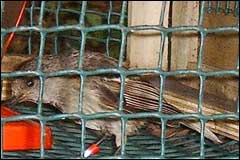|
|
|||
|
||||
|
Updated: September 6, 2001 |
|
|
|||||||||||||||||||||||||||||||||||||||||||||||||||||||||||||||||||||||||||||||||||||
 A female hihi sips from the extra food supplied by DoC staff |
|
|
New Zealand has three honey or nectar feeding birds: tui, bellbirds and hihi.
Hihi are the most threatened of these three species and are very rare. Hihi have been introduced to Tiritiri Matangi over recent years with 35 being released in 1995.
For the first time at a release site, they are in natural competition with the other two honeyeater species in New Zealand - tui and bellbirds. The tui and bellbirds fiercely protect the more energy rich upper forest layers of nectar and fruit. The hihi are left without a good food supply in the lower sub-canopy and shrub layers. This often prevents them from feeding on many kinds of high-energy nectar and fruit.
On Tiritiri Matangi DoC staff have taken action to compensate for the lack of rich food supplies at the lower canopy levels. A specially designed feeder allows the smaller hihi to feed on the honey and water solution. The netting is too small for the larger tui to get in.
As trees such as pohutukawa and puriri establish themselves, a natural supply of nectar will be available to the hihi in the future.